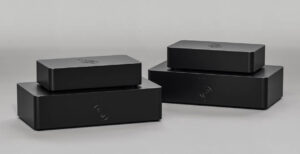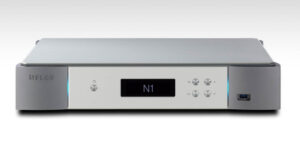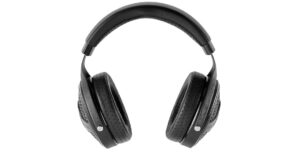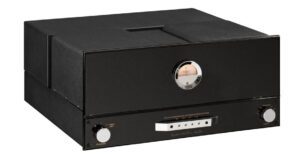
Some systems here are easy recommendations, because they are the output of a single brand. Others are more a reflection of listening tests along the way. This one is slightly different. It’s taking two known products that work in a predictable manner, and applying – sight unseen, and sound unheard – a third in the hope that they work together. It’s a little more than ‘throwing a system together’ because the idea here is that the character of player and amplifier works in dynamic and harmonic balance with the loudspeakers. Fortunately, it works entirely as expected. Phew!
The system here comprises Hegel electronics and Graham Audio-designed Chartwell loudspeakers. The Hegel equipment is not only ‘known’ to us, but is a firm favourite round these parts, and both products in this system have been reviewed in their own rights. Indeed, the Mohican CD player is presently our Disc Player of the Year.
As both the Hegel Mohican disc player and the Hegel H80 integrated amp have been reviewed by Hi-Fi+ (in issues 139 and 107 respectively), we’ll not go over too much old ground. Suffice it to say the CD player is a pure 16-bit, 44.1kHz design with a proper, dedicated CD-audio transport mechanism. OK, so it’s a pure CD player that draws heavily from the company’s top HD30 converter, and that means its own 32-bit AKM DAC chip is barely breaking sweat in handling CD-era PCM.

The Hegel H80 amplifier meanwhile was the first in Hegel’s redesigned approach to amp making, including more digital audio products at the deliberate expense of additional analogue inputs, making the amplifier more of a ‘now’ hub in the process. The 75W amp – codenamed ‘PIGLET’ in design – uses a 24-bit, 192kHz, AKM4399-based DAC sitting on top of the analogue line-stage, but in this context its the combination of XLR and RCA line level inputs that garner our attention, as these are how the Mohican and H80 work best. Personally, I prefer the single-ended options in both devices. Both devices benefit from common Hegel design practices, most notably Bent Holter’s SoundEngine local error cancelling system in the amplification sections of both devices. For more details on these two devices, see the reviews in issues 139 and 107, or on www.hifiplus.com.
Instead we’ll focus more on the Chartwell LS6 loudspeakers. Chartwell is one of those great names from audio’s past. It was also one of the original licensees of the BBC LS3/5a, and minty loudspeakers from the early 1970s change hands for breath-taking amounts, especially among Japanese audiophile collectors. The brand didn’t have quite the staying power of the likes of Spendor, however, and the name laid fallow, lost to the annuls of audio history until Paul Graham of Graham Audio picked up the brand, and restarted it with the LS3/5.
The LS6 is a sort of ideal ‘tweener’ product, coming between the LS3/5 and the LS5/9 in the Chartwell and Graham Audio ranges. And as ever, the BBC connection is kept by Graham’s use of the design services of Derek Hughes, son of Spencer Hughes, who worked in the BBC’s Research & Development centre at Kingswood Warren in the 1960s and early 1970s. Many of the classic BBC loudspeakers were ‘Spen’ designs (Hughes later co-founded Spendor with his wife Dorothy, the brand name being a portmanteau of ‘Spencer’ and ‘Dorothy’) and in Derek, the apple has not fallen far from the tree. Also, Chartwell continues to use Volt loudspeakers specially made for the company, and features those thin-walled cabinets that the BBC made so famous.
The LS6 is a cherry finished, rear-ported, 17 litre two-way standmount design, featuring a long-throw 165mm polypropylene mid/bass cone unit, coupled with a 19mm dome tweeter. That port is a big-un, and vents to the top half of the rear panel, with a single set of gold-plated speaker terminals at the lower half. There is a three-way switch on the front panel that allows a +1dB and +2dB treble lift, to accommodate for well-damped rooms or off-axis listening. This is next to the tweeter behind the grille, which is designed to be kept in place throughout listening (if you remove it, the lip surrounding the front baffle does give a noticeable baffle-step notch in the response).
The 165mm mid/bass unit is the perfect combination for a BBC-type loudspeaker in a world that has, somewhat regrettably in many opinions, moved on from Radio Three and a steady diet of classical music. It’s in the Goldilocks spot between the ‘taut but light’ output of the smaller driver on the LS3/5 and the ‘big but relaxed’ sound from the larger unit on the LS5/9.

The loudspeaker is a perfect partner for the H80, being rated at a somewhat below average 87dB sensitivity, but with an easy nominal eight ohm impedance. It is recommended to be used with amps from 50W-150W and the H80 fits perfectly in the middle of that range. The loudspeakers are designed to play at 100dB and beyond fairly comfortably with an amp of the H80s size. In a typical mid-sized 12’ x 16’ UK living room, this is more than loud enough to be uncomfortable, although if you are a true party animal who feels good sound only exists at the threshold of pain, other loudspeakers (and regular hearing tests) are recommended.
The traditional wadding within a BBC loudspeaker was Dr. Bailey’s Long-Haired Wool, but Rockwool has replaced that here. Sadly ‘Dr. Bailey’s’ is no longer in existence, and the alternatives are either impractical or not sonically superior to Rockwool.
With such a large rear port, the LS6 does require a lot of space between it and the back wall. It’s not the kind of loudspeaker that fits the term ‘bookshelf’ anyway, but if it can be at least a metre from the rear wall, that should be a good start, In fact, the closer it gets to 1.3m or more, the better. This is somewhat at odds with other designs in the Graham and Chartwell lines, which are either sealed box or front-firing designs and therefore can work reasonably close to the wall. Depending on your seating position, they work best on stands between 450mm and 550mm high, but can work well with 600mm stands, too. Fortunately, weighing in at 9.5kg each, and with a relatively low centre of gravity, the LS6 is not a stand-crushing weight. The choice of stand material doesn’t appear that important, although resting on lower mass stands seem more in line with the LS6 bass than being bonded to high-mass models. The latter, in extremis, can seem to add too much of a legato bloom over the bass and upper bass.
Careful installation is handy, but not to the point of obsession. Get them level, toed in, and in approximately the right position and the system will sound good. Spend two more days tweaking them until they are in the perfect position and they will sound ever so slightly better. This is a loudspeaker that works well with an installation that owes more to measuring the room and trigonometry, than it does to magic spells, numerology, and ley lines.
A word about cables. One word. Meh! That’s all you need to know. The high nominal impedance of the Chartwell design makes the differences in loudspeaker cables relatively minimal, and the justification for shooting the moon in audio cable terms is lessened. That’s not to say the quest for better audio simply goes away in this system, because it’s a great sounding system that can be improved through careful accessorising, but that the nature of the improvements cables, cones, and the rest are not as direct, as immediate or as necessary as heard in other systems. Hegel favours Nordost cable in its listening tests and demonstrations, and we used the company’s Blue Heaven-grade product line throughout the test, but there was no burning desire to explore the cable brand’s upper slopes here.
The reason for the pairing between Hegel and Chartwell was the concept of dynamic balance. The Hegel components are a little bit forward, while on past form from the company, the Chartwell should be slightly laid-back sounding. The two should, in theory, balance out. And that’s largely what happened.

In fact, the LS6 is not as laid-back as that past form suggested. It’s perhaps the most forward, dynamic, and exciting loudspeaker we’ve heard from the Graham/Chartwell stables to date (Graham Audio’s VOTU – Voice Of The Universe – flagship may well steal that crown, but it is as yet untried and untested by the magazine). It still holds to the character and charm of a classic BBC design, though. It’s just a little more forward, upbeat, and dynamic. And that really does fit in with the general tone of the Hegel pairing. However, as is common with many such BBC-inspired designs, the importance of that matching process is not pivotal.
The overall system has outstanding imaging properties, and this will probably be the first thing anyone notices in context. With a slight toe-in of the speakers, you get a true sense of three-dimensionality to the music played, especially when that music is live and unamplified. ‘Black Is The Colour’ by Christy Moore from Live At The Point [Frontline] is a live recording with an appreciative audience, and the sense of hearing someone sitting on a stage in front of a crowd is truly palpable. This recording is also used a lot by the ‘Rhythm’ crowd, because it’s simple and has a very good beat. And it’s here where the combination makes its deepest mark. The Hegel duo impose a fine sense of rhythm, without it descending into an overt, obvious, and plodding rhythm line. OK, if you want the kind of almost preternaturally fast, taut rhythmic precision of small, sealed boxes you need a small, sealed box (Star Trek rules: Ye Cannae Change The Laws o’ Physics, Cap’n), but this is a good compromise between the musical honesty and spatial integrity you get from more laid-back designs and the inaccuracy of fast, bass-light boxes.
Going deeper, where the system works well is its ability to tease out the component parts of the music. Not simply in terms of individual instruments within a soundstage, but in terms of blocks of melody, and harmony, and how they interplay in more complex works. A fine example of this is the classic Kleiber/Vienna Philharmonic renditions of Beethoven’s 5th and 7th Symphonies [Deutsche Grammophon]. The second movement of the Seventh is a remarkable interplay of themes that is so well-known we almost hear it unconsciously and fill in the blanks, but with this system in place, the individual themes ebb and flow around the orchestra with consummate ease. Moving across to some jazz, the same applies. As Cannonball Adderley starts blowing changes after Miles’ break on ‘Autumn Leaves’ [Somethin’ Else, Blue Note], the sense of fluidity is more than just tonal (his sax playing is very legato), it’s getting to the way he’s working chromatically, all brought back to some form of epic calm and sanity by Hank Jones’ piano playing. This is the kind of system that not only makes sense of this piece, but makes it enjoyable.

A final truly strong point of the system is its ability to render speech and vocals. While writing up notes on this system, I decided to pull out of storage the original BBC Radio version of The Hitchhiker’s Guide To The Galaxy on CD [BBC Publications], and was sucked back into the radio play like it was 1978 all over again. The sonorous tones of Peter Jones as ‘The Book’ were portrayed beautifully, and there was a sense of layering between the vocal talent and the slightly (deliberately?) cheesy radio sound effects, and quite a lot of Tomita, Ligeti, and Brian Eno’s ambient works.
The only significant downside to this system is not a consideration in context. However, if you decide you want something more than just CD replay, and end up relying on the on-board DAC, it will come as a bit of a let-down after the clarity and rhythmic drive of the Mohican. I guess that’s only to be expected (an on-board DAC on an entry-level amp is probably not going to sound as good as the flagship CD player that costs far more), but it means if you want other digital sources to match the Mohican’s performance in outright terms, you are going to have to use an external DAC, and that means using up valuable line inputs on the DAC.
This is a system that in no small part challenges the concept of synergy. OK, so the CD player and amp are from the same brand, but aside from sharing a remote control, the synergy aspect of this partnership is actually quite low. The player delivers a uniformly good sound, and the amplifier is good at making that sound loud enough to drive some loudspeakers. If you swapped player or amplifier brands, this system wouldn’t decompose as a result. Moreover, and probably more importantly, the expected match between system and loudspeaker didn’t ‘make’ or ‘break’ the system. A system can sometimes be only as good as the sum of its parts, but all of these parts are excellent in their own right, and this time that ‘sum of the parts’ aspect is simply not important.

This is one of those easy bets, a ‘fit and forget’ system that makes a damn good sound, but doesn’t leave you with the drive to improve upon that sound, through judicious tweaks and changes. It is what it is. Instead, what Hegel and Chartwell make here is a system that is easy to live with for the longest time, not some ‘pipe and slippers’ presentation and fun enough to rock out, but not something wild and unstable. In short, the kind of system you never need to fuss about. Best of all, for less than £7,500 all in, this system comes very highly recommended!
Prices and contact details
- Chartwell LS6 loudspeakers: £2,195 per pair
- Manufacturer: Graham Audio
- URL: www.grahamaudio.co.uk
- Tel: +44(0)1626 361168
- Hegel Mohican CD player: £3,900
- Hegel H80 integrated amplifier: £1,350
Manufacturer: Hegel Audio Systems
URL: www.hegel.com
Tel: +47 22 60 56 60
<attachment></attachment>
Tags: FEATURED
By Alan Sircom
More articles from this authorRead Next From Review
See all
Reiki Audio SuperSwitch Master Pro + Servant Pro
- Mar 27, 2024

Melco Audio N1-S38 music server
- Mar 27, 2024

Focal Utopia 2022 headphones
- Mar 27, 2024











